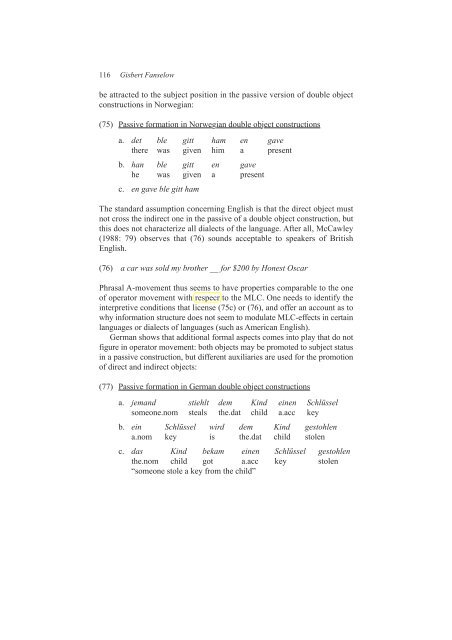Minimality Effects in Syntax · The MLC and Derivational Economy ...
Minimality Effects in Syntax · The MLC and Derivational Economy ...
Minimality Effects in Syntax · The MLC and Derivational Economy ...
You also want an ePaper? Increase the reach of your titles
YUMPU automatically turns print PDFs into web optimized ePapers that Google loves.
116 Gisbert Fanselow<br />
be attracted to the subject position <strong>in</strong> the passive version of double object<br />
constructions <strong>in</strong> Norwegian:<br />
(75) Passive formation <strong>in</strong> Norwegian double object constructions<br />
a. det ble gitt ham en gave<br />
there was given him a present<br />
b. han ble gitt en gave<br />
he was given a present<br />
c. en gave ble gitt ham<br />
<strong>The</strong> st<strong>and</strong>ard assumption concern<strong>in</strong>g English is that the direct object must<br />
not cross the <strong>in</strong>direct one <strong>in</strong> the passive of a double object construction, but<br />
this does not characterize all dialects of the language. After all, McCawley<br />
(1988: 79) observes that (76) sounds acceptable to speakers of British<br />
English.<br />
(76) a car was sold my brother __ for $200 by Honest Oscar<br />
Phrasal A-movement thus seems to have properties comparable to the one<br />
of operator movement with respecr to the <strong>MLC</strong>. One needs to identify the<br />
<strong>in</strong>terpretive conditions that license (75c) or (76), <strong>and</strong> offer an account as to<br />
why <strong>in</strong>formation structure does not seem to modulate <strong>MLC</strong>-effects <strong>in</strong> certa<strong>in</strong><br />
languages or dialects of languages (such as American English).<br />
German shows that additional formal aspects comes <strong>in</strong>to play that do not<br />
figure <strong>in</strong> operator movement: both objects may be promoted to subject status<br />
<strong>in</strong> a passive construction, but different auxiliaries are used for the promotion<br />
of direct <strong>and</strong> <strong>in</strong>direct objects:<br />
(77) Passive formation <strong>in</strong> German double object constructions<br />
a. jem<strong>and</strong> stiehlt dem K<strong>in</strong>d e<strong>in</strong>en Schlüssel<br />
someone.nom steals the.dat child a.acc key<br />
b. e<strong>in</strong> Schlüssel wird dem K<strong>in</strong>d gestohlen<br />
a.nom key is the.dat child stolen<br />
c. das K<strong>in</strong>d bekam e<strong>in</strong>en Schlüssel gestohlen<br />
the.nom child got a.acc key stolen<br />
“someone stole a key from the child”
















